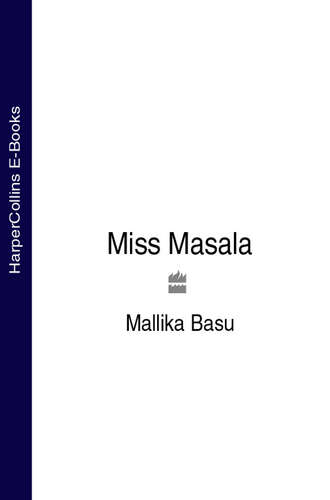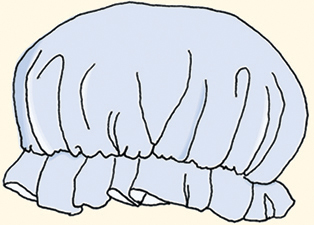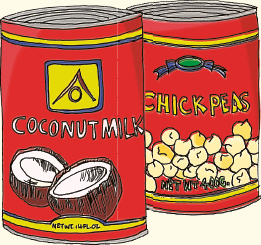
Полная версия
Miss Masala
During my next food-shopping trip, I contemplated the complex equation of effort vs. reward. The answer seemed to be a pot of curry powder. This premixed ingredient is the mainstay of recipes in dog-eared women’s magazines at the dentist and the doctor’s. On the surface, it sounds like a godsend. A blend of essential whole spices such as cumin, coriander, chilli, cloves, black pepper, etc., ground into an all-purpose curry powder. Ready for whatever Indian dish you are planning to cook.
Easy, but so boring. I tried it with chicken. Then lamb. Next with vegetables. Everything tasted the same – of supermarket own-brand curry powder. This isn’t in the spirit of true Indian cooking. Half the fun is in the variation, adding a little bit of this and a little bit of that to end up with something truly unique. It was also far too reminiscent of the dried fruit and nut British homemade curries of the 70s. I cast the stuff aside and made once more for my haven of masala salvation – the Indian Spice Shop.
Here, I sought another vaguely familiar spice shortcut of the past. In my student years, Mother had taken to sending me presents via any willing London-bound relative. The parcels contained contact-lens solution (‘much cheaper in India’), boxes of sugary Indian mithai and cartons of recipe-specific spice blends, including ready-mixed meat masala, chicken masala and the optimistically named Kitchen King.
Alas, I hadn’t made the most of these gifts. My student brain cells had been reserved for the pursuit of an education in business, contemporary fashion and the exploration of illegal substances. But now I was a changed person. A clean and respectable, tax-paying, law-abiding goddess-in-the-making. I loaded the rickety basket with channa masala and kadai gosht masala and filled whatever space was left with cartons of Kitchen King.
In my apartment, the back-of-the-pack recipe for sautéed chickpeas instantly appealed. I stir-fried some onions and tomatoes; added 3 tablespoons of channa masala powder, and the tinned legumes became my new best friend. I sighed, ‘You complete me’ under my breath as I toasted wholemeal pitta bread. And then the doorbell rang.
It was a fellow would-be goddess in pink velour track pants – my neighbour from downstairs. Also third cousin, i.e. immediate family, and close friend. She wanted to borrow some serving dishes. ‘Are you cooking channa?’ she enquired as I threw the door open. ‘Yes. Doesn’t it smell great?’ I replied. I quickly ate a massive bowlful in front of the telly after she left and put away the leftovers to take for lunch at work. But as I walked through the corridor the next morning, nose twitching, I wondered what the neighbours thought of my kitchen wizardry.
It wasn’t just the corridor of our porter-guarded tower block that had been overtaken by the potent whiff of the spice blend. It had infiltrated my two tiny bedrooms, the inbuilt closets, my jewellery chest and every millimetre of upholstery. I frantically aired the flat, opening windows wide and lighting scented candles, but the smell of channa masala lingered on. Three days later when my neighbour came over to return the dishes and chat, I could smell the stuff emanating through the pores of the battered blue Ikea sofa.
The first lesson here was that chickpeas are the ultimate Indian fast food. The second and more important lesson was that ready-made spice blends do not always the best shortcuts make. The search for culinary tricks continued well into the next year of my big cooking adventure. And this is what I concluded: spices smell, so plan Indian cooking carefully.
Curry hair is never going to be the height of style. Every time I rushed out to party after a spot of cooking, I might as well have been balancing a pot of saag gosht on my head. Too self-conscious to show off my dance moves, I’d stand in a corner and drink myself silly instead. My dinner-party guests were subjected to it, too. No one ever thanked me for dry-cleaning bills for coats smelling of the jeera aloo I had served earlier.
The truth is that Indian spices smell pretty strong. I couldn’t avoid using them, so I just got smarter about managing them. It was a bit like smoking in my teenage years. Knowing my parents might catch me lighting up in the house didn’t make me stop – just encouraged me to stock up on air freshener and chewing gum.

THIS IS HOW TO SET YOUR HOME FREE OF SMELLS:
COOK A DAY IN ADVANCE IF POSSIBLE.
A bit of clever social diarising and the night before a dinner party is a quiet one in. I cook all the food early and put it in the fridge to reheat the following evening. I don’t worry about serving guests stale food because Indian cuisine always tastes better the next day. Ingredients slowly soak up all those heady spices and develop far more intense flavours. In India, leftovers served at an ‘after’ party are always better than food freshly cooked for the party itself. My guests are inadvertently bestowed a great honour and cherish me even more for it. (I’m guessing.)
When I’m being super well organised (a rare feat), I cook a few days in advance and freeze the dishes. All they need is overnight defrosting and, again, a quick reheat before the meal. With the cooking dealt with in advance, on the actual day I can spend the time tidying up, getting changed and placing flowers in vases.
DRESS APPROPRIATELY.
I’m not Eric the dry-cleaner’s favourite customer for nothing. I often come home battle-worn from work or desperately hungry after a few drinks with friends and start cooking in my suit. While snacking on microwaved papads and mango pickle.
It’s taken a hefty cleaning bill to partly shake off this messy habit. Now my top trick is to quickly change into a pair of old pyjamas and don a shower cap to protect my hair. The shower cap looks stupid. But it does save me the bother of washing and recreating the do when there was nothing wrong with it in the first place. And I can rip the cap off in seconds if someone shows up unexpectedly.
IF YOU’RE IN A RUSH, COOK LOW-SMELL RECIPES.
Usually, I’m dashing around on public transport. Racing to get dinner on the table before that all-important episode of a vacuous TV talent show. Or trying to line my stomach before a long night ahead. With a strictly limited window of opportunity to transform from spice girl to sizzling siren.
For occasions like this, low-smell recipes are the best ones to go for. As a rule, frying onions with lots of powdered spices will fill you and your kitchen with strong aromas. The dishes to go for are a one-pot healthy pulao or a dal brimming with vegetables. If I do choose to make a curry, I pick those that use only a few spices or have a herby base.
AND FINALLY, PREPARE THE HOME.
I’m no Mrs Beeton, but keeping an apartment smelling fresh and wonderful is pure common sense. I keep the kitchen door shut tight and the windows open wide to prevent aromas from creeping into the other rooms. Then the scented candles come out. For a bit of added authenticity, I have a stash of super-strong incense sticks at the ready. Play some Bollywood tunes and it’s the perfect setting for a proper Indian meal.
Before I move on, though, I have to say this. If you don’t like the aroma of Indian food, you’re reading the wrong book. If it’s your man who doesn’t like it, this is the perfect moment to finally rid yourself of him.
Gizmos and Gadgets SAVING THOSE PRECIOUS MINUTES
Inspired by the equipment used by professional cooks, I bought sturdy aluminium pots and pans for cooking Indian food. Big mistake. Those professional types have extra-strong arm muscles and masses of patience (not to mention an army of underlings to scrape off the leftovers). They also don’t get distracted by The X Factor and glitter-vest ironing. I discovered soon enough that the best shortcut of all is to use the highest-quality non-stick cookware I could afford.
It started a mini revolution in my kitchen. Within a week I had bought my first ever hand blender. This miraculous gadget saves nails like a Korean manicurist. I could now purée fresh ginger and garlic, whiz up some kebab marinade and even make a mango lassi. Thankfully for me, the blender came with completely idiot-proof instructions and a splatter-proof beaker.
Over the years, I have amassed a grand collection of kitchen gadgets, some exceptionally useful and others utterly pointless. The chopper does a remarkable job of dicing small quantities of vegetables like onion, cucumber, root ginger and garlic. The rice cooker I will take to my grave. The mini electric coffee grinder finely powders in seconds homemade spice blends for dhansak, sambhar and tandoori chicken.
The food processor, on the other hand, is scary to look at. Exhausting to drag from its special shelf and monstrous on the worktop. Except for grinding small quantities of dry ingredients, the mortar calls for too much pestling. The less said about the juicer and the herb chopper the better.
The most life-changing of all gadgets has, without a smidgen of doubt, been the pressure cooker. No Indian kitchen is complete without a selection of them in different sizes. I wasn’t always convinced, though. My first doubts about it were sown in my friend’s New York kitchen. Turns out she put some vegetables in the contraption and wandered off to shower and blow-dry her hair. The next thing she heard was a muffled explosion. If the battered pan wasn’t enough to send a shudder through her Molton Browned body, there was green vegetable mush plastered all over the ceiling.
An internal voice instructed me to stay as far away from explosive kitchen devices as possible. But once I’d learnt not to get too distracted and wander off, I couldn’t help warming to the idea of a pressure cooker. What’s not to like? It cuts cooking time by using steam pressure on the food, saves electricity and, by default, the world. Who says a goddess can’t be a part-time eco-warrior?
The first time I used one, I sat patiently at the kitchen table waiting for the reassuring whistle. Too scared to go anywhere; too petrified of what might go wrong. Nothing ever did. Now I’ve acquired two. One large one and a smaller version perfect for a meal for two.

TOP PRESSURE-COOKER TIPS
1 Never fill the pan to more than a third.
2 When cooking dal, wash well and add a teaspoon of oil to reduce foaming.
3 Fry up your spices first in the same pan before you stick the lid on, rather than frying them up separately and adding them after the dish is cooked, as they will still taste raw.
4 Don’t shake the pan when the lid is on.
5 Release steam by gently lifting the weight on top with a long-handled wooden spoon and keep out of the way of the little vent holes.
Cooking Shortcuts THE SEARCH CONTINUES…
Alongside my quest for life-changing gadgets ran the search for food shortcuts. The attempt to make my own paneer started it. I curdled almost a gallon of milk but ended up with only a tiny block of too crumbly cheese. This was clearly the food equivalent of big box, little present. For a whole day’s work too – Google research included.
It hardly encouraged me to make my own coconut milk, garam masala, ghee or tomato purée. Ready-to-use ingredients form the basis of a multibillion-pound industry for good reason. I salute them. Particularly the ones that offer high quality and convenience. Sadly, some solutions – like ready-puréed ginger and garlic – don’t always make the cut. They can be more anaemic than the real thing. I keep a store-bought jar of each handy but if you have the time, these two ingredients are definitely worth fiddling over (see the box).
MY FAVOURITE COOKING SHORTCUTS






THE TRUTH ABOUT MAKING GHEE
I would love to make ghee from scratch some day. But I couldn’t possibly recommend it. It takes 3 hours plus to make. My entire flat would then stink of grease for the rest of eternity. Far better just to stick to the bought stuff.
Simplify Meals
Back home in India, meals ranged from little snack platters to multi-course madness. The elaborate ones featured dal, a meat or fish curry, two vegetable side dishes served with papads, deep-fried shredded potatoes, salad and raita. These were served at weekends and extended family dinners.
Then there were the simple Indian meals, mainly for weekdays or weekend brunches. Like a lamb pulao with Kachumbar Raita. Or shallow-fried parathas stuffed with spiced carrots and served with a selection of pickles and thick natural yoghurt.
And finally, there were the intermittent snacks. The little nibbly things for when you came home famished from swimming lessons or drama classes. Like aloo tikkis and fish chops – little pan-fried croquettes served with coriander and mint chutney.
The same principles apply in my kitchen. Except that we like variety. So Indian curries are limited to two meals a week. My trick is to keep it simple when it’s just the two of us on a weekday. Choose one or two wholesome dishes and serve them up with something low fuss. For example:




COOKING CRISPY PAPADS
For the best results, cook for 1 minute on high in the microwave. No need for a plate. If you don’t have a microwave, pop directly on the hob (gas or electric) for 1 minute, turning until evenly crispy on both sides.
Cooking two or more dishes at the same time calls for some dedication. So this I reserve for weekends when I push the boat out with a few additional dishes like raita or sabzi. This works wonders for when a friend pops in too. I might make:



For dinner parties, it’s more of the same, with fancier recipes and a quick dessert. I cook a few dishes in advance in large quantities and either freeze them or keep them in the fridge. I then reheat them just before the meal, either in the oven or the microwave. The trick is to leave as little to do on the day as possible.
Larger crowds and wilder soirées call for clever thinking. The simplest thing to do, I’ve found, is to cook large batches of filling food. Little parcels, croquettes and other bits that need to be individually fashioned and then fried are definite no-nos. The ingredients of choice for me are chicken drumsticks, potatoes, vegetables and lentils that can be grilled or left to bake while I get pretty. Laid out with some homemade chutney and flatbread, they effortlessly make me the life and soul of the party.
Cooking Extra to Save Time in the Future
Cooking for eight in order to feed two is a sub-continental cultural phenomenon. Where I come from, it is customary to feel overwhelmed by hospitality and the vast quantities of food served. Who am I to disregard years of ritual overfeeding?
In fact, this time-honoured tradition works rather well for me. If I’m going to forgo speed-dialling my local Japanese takeaway, I want to savour the results more than just once.
This means I have a special relationship with Tupperware. I buy a lot of it but deplete most of my supply by drunkenly distributing doggy bags to guests after dinner parties. Then I start stockpiling them again. My fridge contains more Tupperware than food. There are boxes filled with half-used vegetables, leftover chopped tomatoes and fresh puréed ginger and garlic paste.
We eat our fill of what was cooked the day before. The remainder gets stashed away in the freezer for another day’s feast. I’ve worked out that you can freeze just about anything: dal, chicken curry, lamb curry and so on. But not cooked potatoes or rice. I learnt the hard way that they get horribly soggy when you defrost them at room temperature or in a microwave.
How long the stuff lasts in a freezer clearly depends on the appliance. In the knock-off, creaking freezer supplied by a penny-pinching landlord, I could wait about a month before sensibly emptying the contents of rock-solid Tupperware. In my glossy, second-hand Smeg, I give each frozen box about two months.
And each time, the food tastes even better defrosted and reheated. Firstly, because it’s the flavoursome leftovers (as explained on page). Secondly, because I didn’t have to cook it from scratch on a day when I simply didn’t have the energy to do so.
WHEN AND WHAT TO DRINK WITH INDIAN FOOD A CAUTIONARY TALE
When I gained enough confidence in the kitchen, I invited my colleagues for dinner. The drinks were flowing. Nerves (mine) were running high. I drank one glass of wine. Then another while they waited to be fed. Before I knew it, the room was spinning and the food looked as green as I felt.
Staying sober until the curry’s cooked is a difficult task. I tend to join the festivities prematurely. Which inevitably leads to last-minute, bleary-eyed panic.
The odd glass of alcoholic beverage while cooking curry is a must. It fills me with the confidence of a teenage Ferrari driver. But it’s hard to stop there. So when the pressure is on (i.e. my boss is waiting to be fed/colleagues are relying on my party snacks) I simply avoid drinking until the food’s on the table. And overcompensate for the abstinence later.
The tipple of choice is almost always a good-quality vodka or gin. Both are non-acidic, highly distilled, refreshingly smooth and go perfectly with a dash of tonic water and Indian food. Saying that, I also consume copious amounts of wine with curry. This is not always the best idea for food cooked with yoghurt, chillies and spices. Acidic, oaky or tannin-heavy varieties are best avoided, judging from my morning-after experiences. When in doubt, I read the labels. ‘Fruity’ and ‘easy to drink’ are the buzzwords to look out for.
There’s beer too. Which I know little about and avoid at all costs to save my gut from an expansive fate. When I’m buying it for guests, top choices are Asian varieties like Cobra, Kingfisher or Tiger beer. Works a treat every time.
BEFORE YOU START, REMEMBER THIS:






2.
PERFECT IN NO TIME
Quick recipes for when you’d rather not be in the kitchen
Miss Masala.

YET ANOTHER CLIENT CRISIS, the biggest new business pitch ever and two long meetings. Being part PR consultant and part domestic goddess can be hard going. Still sitting at my desk at eight in the evening, editing version 25 of what was once an interesting report on a riveting subject, I was considering professional suicide with one quick e-mail.
Dear client, I began, much as I would like to spend the rest of my life editing your insightful document, I no longer have the will to continue. And then, the cleaners arrived. It was a sign from above. My brain entered meltdown mode. I pressed delete and started wondering what to cook for dinner as I grabbed my coat, dashed outside and flagged down a taxi on the street.
All I needed now to unwind was an uneventful ride home and a hearty Indian meal. It’s at moments like this that I am tempted to call the local Spice-Tandoori-Balti-Taj-Mahal-Whatever. For anything with chilli and turmeric in it. That I don’t have to cook myself.
Time seems almost always to be in short supply in my life. Cooking Indian food has to jostle for pride of place in a topsy-turvy week of client deadlines, unexpected guests and last-minute plans with friends. Days are mostly spent planning evenings out with close friends at cocktail bars, restaurants or nightclubs. And then recovering from them.
There is a time and a place for elaborate cooking. Busy weekdays and social weekends most definitely aren’t it. But masala cravings can make me do terrible things. I have ghastly memories of midnight meals. Gammon steaks wrapped in ready-frozen parathas. Soda bread soaked in mango pickle. Cringe-worthy failed attempts to cook dal when drunk. I’ve even come this close to trying out an Australian colleague’s recipe for curry porridge.


